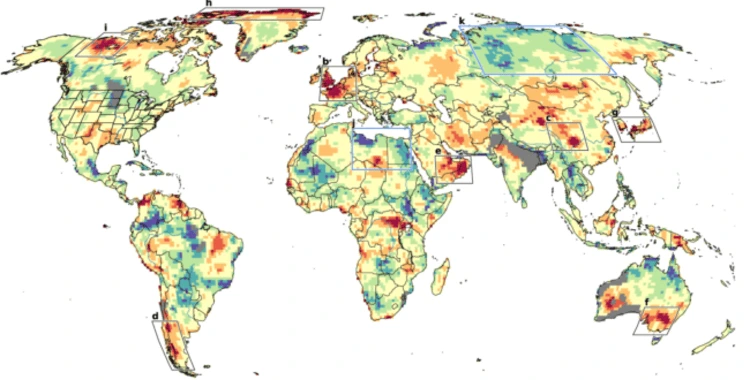
So-called heat wave ‘hotspots’ are on the rise across the world and are having deadly impacts – but where exactly are they?
By
Last year was Earth’s hottest on record, at 1.2 ºC (2.12 ºF) above the 20th-century average, surpassing the previous record set in 2016. So far, the 10 hottest yearly average temperatures have occurred in the past decade. And, with the hottest summer and hottest single day, 2024 is on track to set yet another record.
With temperatures on a clear upward trend, a new phenomenon is emerging: distinct regions are experiencing repeated heat waves that are so extreme, that they fall far beyond any global warming model prediction.
A new study, published in Proceedings of the Natural Academy of Sciences, has provided the first worldwide map of these regions, with giant, red blotches covering every continent except Antarctica. The impacts of these heat waves have been deadly, with tens of thousands of fatalities, withered crops and forests and devastating wildfires.
Enjoying this article? Check out our related reads:
Over the past 65 years, several regions across the globe have seen extreme heat accelerating much faster than their predicted moderate temperature increases. The trend has led to record-breaking events such as the US Pacific Northwest heat wave that lasted for nine days in 2021 and broke daily records in some regions by up to 30º C (54 F).
The highest-ever recorded temperature in Canada occurred during the event at 49.6 ºC (121.3 ºF) in Lytton, British Columbia. The town was burned to the ground the following day due to a wildfire which was driven by the drying of vegetation in the extreme heat.
Causes of heat wave hotspots
The causes of these extreme events vary. The destabilised jet stream, influenced by Arctic warming, is a key driver in Europe and Russia; but drying of vegetation, which prevents evaporation of moisture and regulation of heat is also thought to play a role in the Pacific Northwest, along with heat transport from the ocean.

These types of extreme heat waves are relatively new, hitting areas predominantly in the last five or so years, though some occurred as far back as the early 2000s and before.
As extreme heat events become more frequent and severe, scientists warn that adaptation may struggle to keep pace. Without urgent action, the consequences for health, agriculture, and infrastructure could be catastrophic.
“Due to their unprecedented nature, these heat waves are usually linked to very severe health impacts and can be disastrous for agriculture, vegetation and infrastructure. We’re not built for them, and we might not be able to adapt fast enough.” – Kai Kornhuber, the lead author of the study.
Most impacted regions
The hardest-hit regions caused by these heat waves include central China, Japan, Korea, east Australia, the Arabian peninsula, and scattered regions of Africa. Other regions include North and South America.

According to the report, the most intense and consistent signal comes from northwestern Europe, where repetitive heat waves have contributed to up to 60,000 deaths in 2022 and 47,000 in 2023. These largely occurred in Germany, France, the UK and the Netherlands. These countries are especially vulnerable due to the lack of air conditioning units within residential and commercial settings.
In the US, heat now claims more lives annually than hurricanes or floods, with deaths doubling since 1999. Experts are calling for the naming of heat waves, similar to hurricanes, to raise awareness and encourage preparedness.



